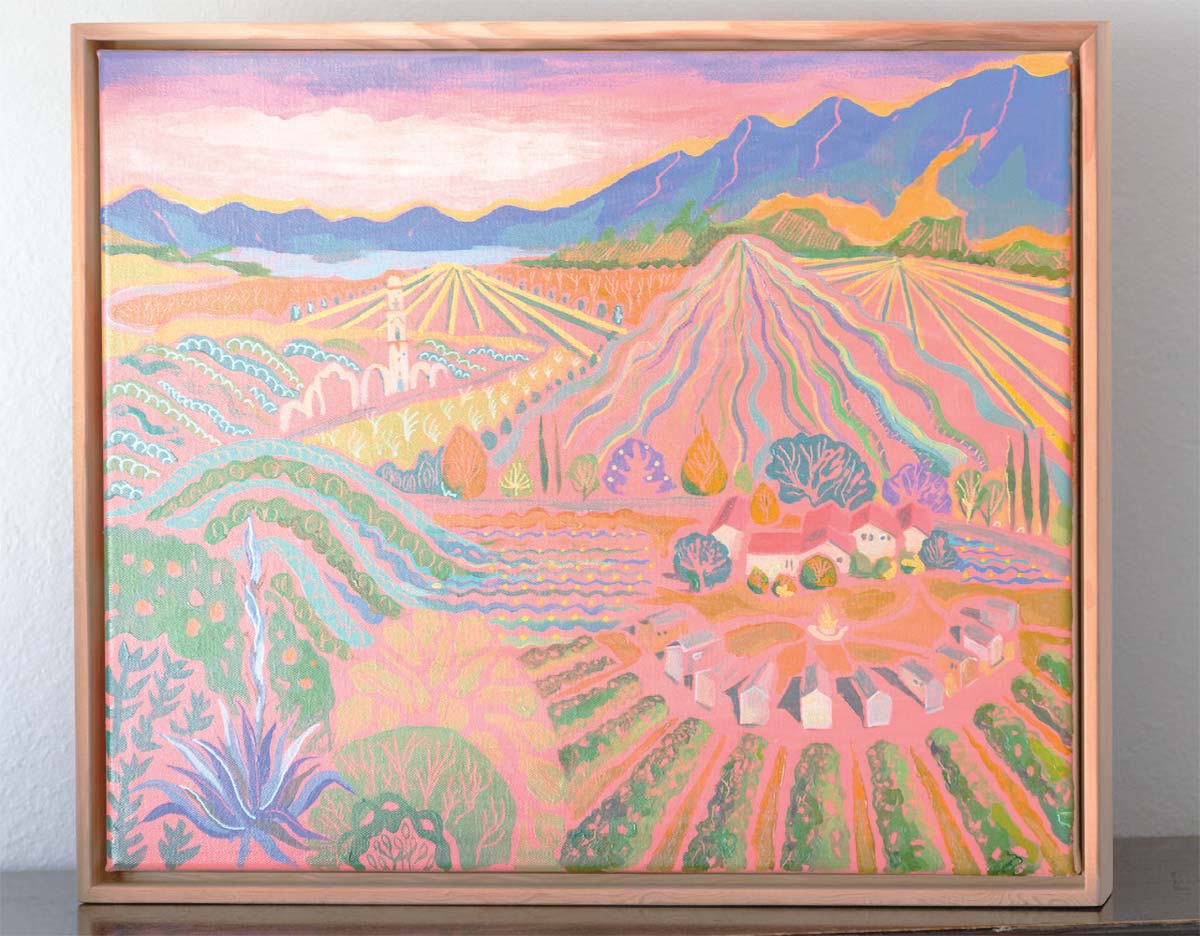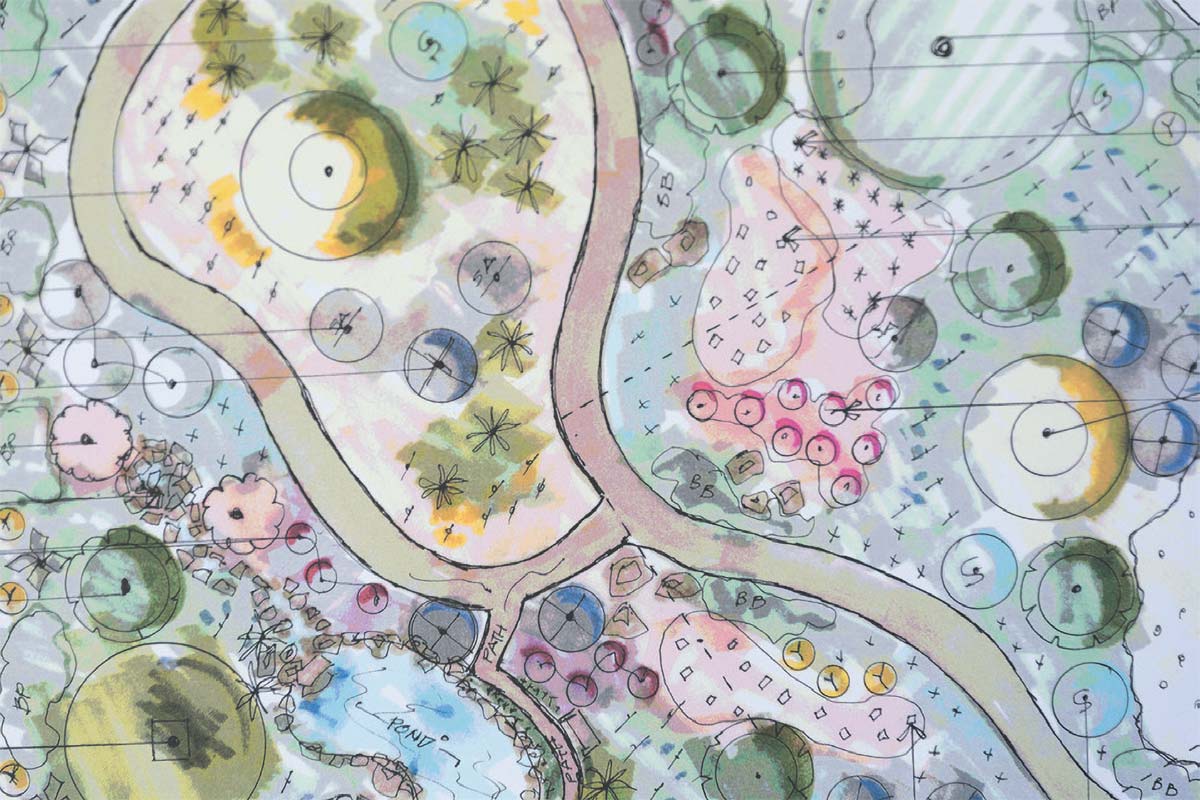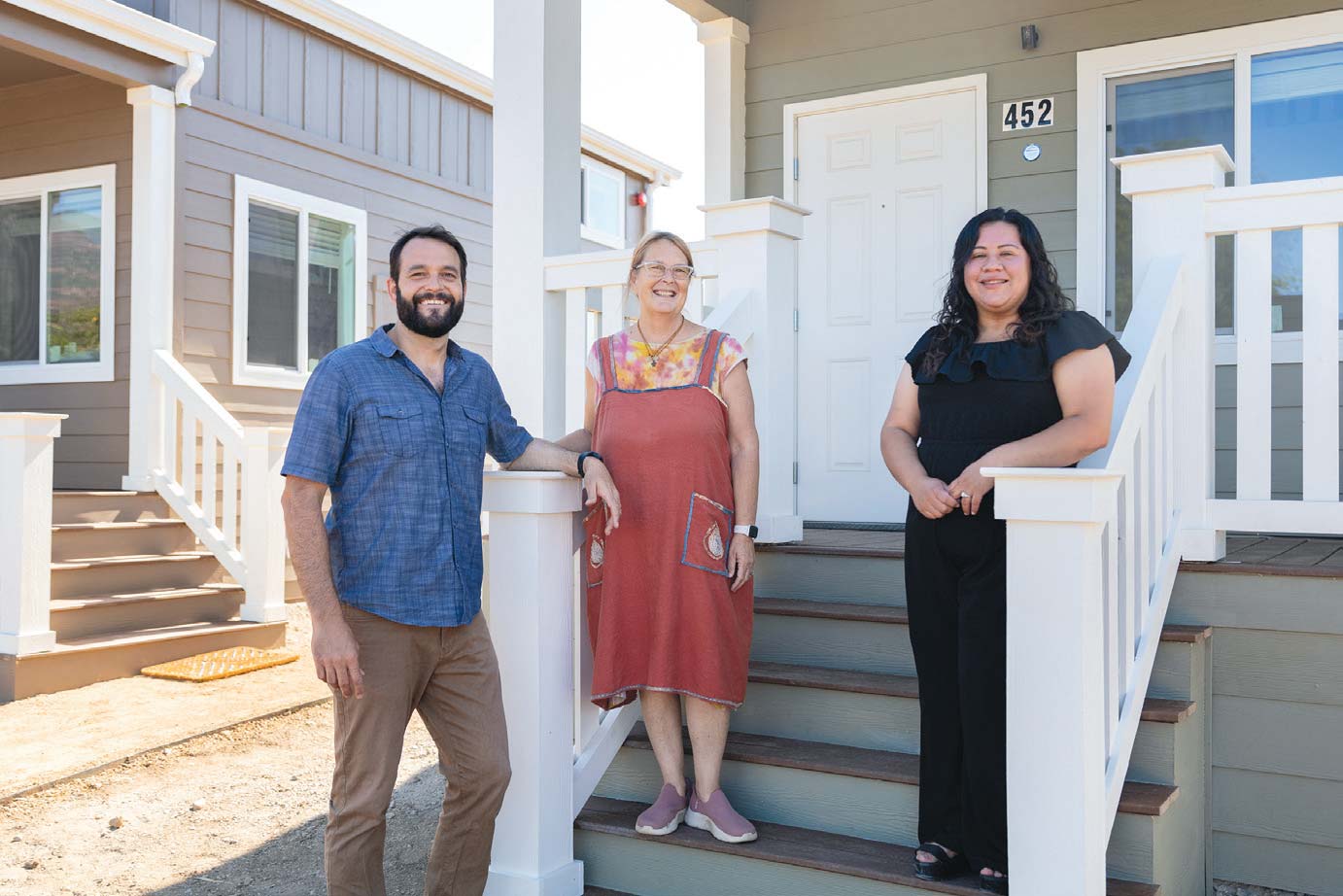Welcome to Mesa
Amid a constant narrative of crisis, of doom loops and drugs and declines, Dan Parziale is crafting a new story about homelessness. It’s one that’s centered on hopefulness and human potential rather than problems of bricks and mortar, although it addresses that topic elegantly with 10 tiny homes on a 10-acre site in the East End of Ojai. The community Parziale co-founded was three years in the making, but this summer, it opened its doors to its first cohort of 12 participants. Welcome to Mesa.
Parziale is executive director of Mesa, a unique program designed to serve the needs of young adults in Ventura County facing homelessness. Although Dan grew up in Ojai, his years of professional experience in service of communities from Haiti to Los Angeles deeply influenced the formation of Mesa.
That experience includes teaching, organizing for United Farm Workers, working at a nonprofit focused on recovery from major catastrophes—and especially the six-plus years he spent at LA Family Housing during a period of ballooning homelessness in that county. While he was there, Los Angeles passed two major bond measures that brought hundreds of millions of dollars into county homeless services. As a result, the agency went from housing a few hundred people a year to a few thousand.
While proud of that work, Parziale was ultimately demoralized. Demand for housing constantly outstripped supply, and he saw firsthand that emergency shelter was not always the appropriate response to the needs of the people being served.
“It wasn’t getting any better,” he says. “Homelessness was getting worse every year. ... We couldn’t catch up.”
Towards the end of his tenure at LA Family Housing, Dan and his family moved back to Ojai, and he continued to commute to LA. In Ojai, he met Kyle Thompson, a co-founder and former CFO of Topa Topa Brewing Co., (now co-founder and CFO of Mesa), with whom he began to reimagine how to approach homelessness. It began with a simple inquiry: “How do we move upstream and prevent homelessness before it starts?” This led to three specific tenets about where to try, who to serve, and for how long.
Ventura County is big enough that when things happen here people pay attention, and homelessness here is a big enough problem that people are paying attention to it. The annual percentage growth of homelessness in Ventura County is the same as LA (about 15–20%, according to Parziale), but the unhoused population is much smaller in absolute numbers. “We have 300–400 young adults living on the street. That’s a number we can do something about,” he says.

A painting of Mesa by local artist Christopher Noxon (Nox)

They are working with Dan Colbeck of Bill Mellett Design on their native landscaping and garden designer April Palmer is developing a native garden with a natural water feature (plans above).

Dan Parziale stands with the “welcome” sign made by Thatcher students.
Existing data shows that young adults coming out of the foster care system or who were housing-insecure while growing up are at high risk for homelessness. Parziale told me that 20% of those who age out of the foster care system are homeless the day they age out, and 50% are homeless within 18 months. As a result, Parziale designed Mesa to address the needs of 18- to 24-year-olds in an attempt to shift their trajectory to a more positive outcome. Anyone in that age group currently in Ventura County and experiencing, or at high risk of, homelessness is eligible to be referred to Mesa.
Parziale also deliberately wanted to get out of the crisis mind-set of emergency housing and provide residents with the experience of security and care on a longer-term basis. As a result, Mesa participants may stay for up to 24 months, and all the furnishings in their accommodations are theirs to take with them when they leave.
Crucially, the longer-term approach also allows the staff of Mesa, and the community at large, to spend more time listening to the residents. “We need to think about the people that we’re working with in a very different way and come to the table with a recognition that we don’t know it all, necessarily ... and that work takes time,” Parziale tells me.
The road to opening Mesa has also taken time. After eight months of building out their vision for the organization, Parziale and Thompson got their nonprofit organizational status, and, at the beginning of 2021, Parziale left LA Housing to work on Mesa full-time. They collaborated with Ventura County on an application for the state Homekey funding; partnered with People’s Self-Help Housing, a local developer of affordable housing; and won a $6.1 million grant consisting of funds from the state matched by Ventura County. That money was used to buy and develop the property in Ojai starting in April 2022.
Parziale jokes he’s spent the last two years as an unlikely property developer, managing the sitework development and installation of the tiny houses. One benefit of the tiny houses—there are also two rooms in the main house that came with the property—is that they allow all genders to reside at Mesa. This is unusual in sheltered housing, which tends to be congregate and therefore single gender. One of the tiny houses is also ADA (Americans with Disabilities Act) accessible, adding to Mesa’s inclusivity.
But the thing that strikes me most about the tiny houses is that they’re lovely—not just the views, which include the bluffs and Chief Peak, but also the comfortable furnishings. The homes are well-appointed, and it’s easy to imagine these as a lucrative cluster of Airbnbs off the beaten track in Ojai. And yet they serve an altogether different purpose.

POTENTIAL FOR FARMING
The Mesa team’s work has also gone far beyond developing the housing on the property, addressing its holistic philosophy of sustainability, both for humans and the land. “Ultimately, we can’t have healthy humans without a healthy environment,” Parziale says.
When purchased, the property had long been a monoculture site growing Valencia oranges. Since then, it has been planted with more than 30 types of fruit—including stone fruit, persimmons and figs—and nut trees and perennials. A vegetable garden is in the works thanks to volunteer local master gardeners, led by April Palmer. And a grant won in collaboration with the Community Environmental Council and the Ventura County Resource Conservation District will allow them to re-wild three acres on the property with all-native pollinator species. The team is also working with the Ojai Valley Land Conservancy and Turning Point Foundation’s Growing Works to supply all of the native seed and plants and with the C.R.E.W. to clear invasives.
“We saw it as a place where we could take ... and invest a lot of energy into it and give it an opportunity to be a healthy space.”
In addition to a commitment to no-till, no-pesticide, no-herbicide farming, they have built out massive water catchment areas to sink water back into the water table. Plans are in place to have all their utility generation onsite, including water from the well and energy from solar.
The outdoor environment also offers the possibility of vocational opportunities for Mesa participants. Parziale illustrates this with the example of 300 beehives from Ariaga Apiary kept onsite this spring and summer, for which Mesa will be compensated with nearly 1,000 pounds of the 16,000 pounds of honey produced. The environment benefits, and the honey provides skills development and money-making opportunities for the participants based on their interests—from label and packaging design to food safety to marketing and sales, at the onsite farm stand and local farmers’ markets. It may even serve as a model of social enterprise to help contribute, albeit modestly, to Mesa’s long
term financial stability, which will also continue to rely on both philanthropy and additional government grants.
“Creating an environment in which we are curious about the needs of young adults facing homelessness and then providing them with opportunities that help them meet those needs is something that’s going to, I believe, lead to some really positive outcomes,” Parziale says.
Mesa will offer both educational and vocational support services, but it’s “really resting on this foundation of mental and physical health and wellness,” says Parziale. This means an expansive view of mental health, inclusive of traditional therapy (which will come from both public and private providers) and also art, breathwork and equine therapy. Breathe Ojai’s Francesca Gold will offer an eightweek trauma-informed therapeutic yoga course.
One of Parziale’s most elucidatory anecdotes starts with a well-meaning hairstylist friend who offered to come onsite to Mesa to give participants haircuts.
Parziale was adamant he wanted residents to have the experience of making an appointment and going into a salon, just like any other customer would experience this routine-for-many act of self-care. It strikes me as the manifestation of a theme Parziale returns to often in our conversation: “When you treat people really really well and you ask them what they need and then help to support them in getting that, things go well.”
Other variations of this theme include “Let’s treat people like people,” and “We need to remember what it’s like to be loved.”
Relistening to my recorded interview with Parziale, my heart breaks a little bit at this last one as I imagine the inevitable disappointments that will occur along this journey. But for all his optimism, Parziale is also a realist.
It began with a simple inquiry: “How do we move upstream and prevent homelessness before it starts?” This led to three specific tenets about where to try, who to serve, and for how long.

Participants in the Mesa community will have the support of live-in house manager Sheila Piala (center) and case manager Maritza Ceja (right). Co-founder Dan Parziale (left) works closely with local farmer Joel Serot of Ojai Mountain Farm on a fertility program to improve the soil health of the property
“We have 12 people here. That’s not ending homelessness. … But this is a pilot. Let’s prove our case. ... Then we either do it again ourselves or with partners. And again and again and again. And/or we are helping to influence and impact how this work is being done in other places.” At the time I spoke to him in May, Mesa was already receiving referrals and expected to receive well over 100 for their 12 spaces.
Parziale is also aware the road may not be a straight one for those who do get a place at Mesa, and he’s clear about how he wants Mesa to be different. “When you mess up, we’re not going to automatically throw you out. Because that is how people who are in tough positions in life are oftentimes treated: ‘We’re going to give you this opportunity, you’re lucky that you get this opportunity, play by the rules or else next person in.’ That’s not the kind of organization that I want to run; it’s not the kind of community that I want to live in.”
So far, all signs indicate that our community is the kind of place Parziale wants to live. Multiple individuals and businesses—including the previously mentioned hair stylist, a local chef, Ojai Mountain Farm, Radical Botanicals, Velvet Heart Equine Therapy, Night Heron Farms and Ventura Spirits, to name a few—are in talks about potential partnerships. Parziale reports almost no pushback from the community, which he attributes to being proactively transparent about Mesa’s mission from the beginning. To the contrary, Ventura County residents have been pivotal in donating considerable time and money to get the project launched.
And Parziale knows community is vital to Mesa’s success. “These are the [people] that need a community that’s going to say, ‘Not here. We are not going to let you fall through the cracks. We are going to wrap our arms around you and ensure that you have the opportunity to pursue the life that you want for yourself.”
When I thank Parziale for his work to get Mesa going, he responds with this: “I do ultimately believe to my core that as good as this will be for the young adults who are living here, it will be just as good for our community. This is going to make us a better community.”

Mesa participants may stay for up to 24 months, and the furnishings in their accommodations are theirs to take with them when they leave, instilling ownership right from the start and investment in their next step to independent living.
MY VISIT TO MESA
BY AVERY LIEB
Did you know that one out of three students in Ventura County are unhoused? Cathi Nye, homeless education program coordinator for the Ventura County Office of Education, asserts that this equates to over 5,000 K–12 students living in homeless situations. As a teenager myself, it’s hard to imagine facing all the challenges of school, family and growing up without a secure home. I’m compelled to help my peers in any way I can, and fortunately discovered incredible work being done to address the young homeless population right down the street from my school, at Mesa.
I shared Mesa’s website with my science teacher, and emailed Mesa to set up a class visit to better understand the organization and how we might help. We decided that each of us in the class would research and raise public awareness around aspects of Mesa’s diverse programming that interested us the most, ranging from nutrition and mental health to employment and housing.
My primary passion is design and how it influences our lives—therefore I was immediately struck by the power of Mesa’s architecture to create a calm, secure environment. There are 10 simple, sturdy cottages that convey a sense of stability, dignity and independence for the young adult living there. At the same time, each home is part of a larger, communal living design, and this promotes a sense of belonging and security. This unique location—10 acres of regenerative Ojai Valley farmland with expansive mountain views—is a vital and integral part of the design that enables participants to heal by finding connection to the earth. Mesa’s holistic design truly embodies its mission to create an integrated, community-centered approach to homeless prevention.
The Mesa design was intended not only to help the well-being of its occupants, but also the health of our planet. To this end, co-founder Dan Parziale told me they focused on integrating sustainability into the design whenever possible. For example, the property’s large water catchment areas collect rain runoff as part of an overarching goal to “eliminate reliance on Lake Casitas.” Furthermore, Parziale hopes to transition Mesa to “100% electric, solar-generated power on site.”
The work being done at Mesa is truly inspirational—they are addressing a complex crisis through simple, down-to-earth design, while nurturing the body, mind and spirit of its community members. So, organize your classmates and friends, visit Mesa and learn how farming and design can improve our lives.




